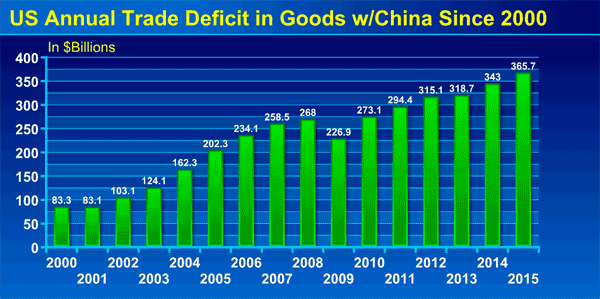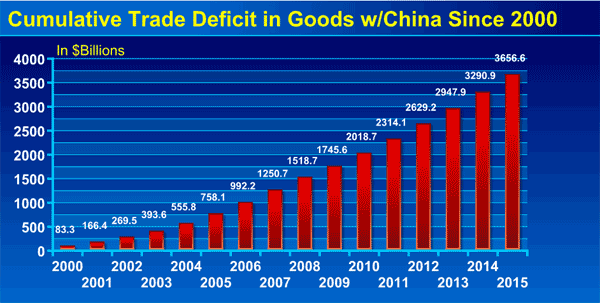The US trade deficit in goods or merchandise rose again in 2015, according to data released last week by the US Census bureau.
Supply Chain Digest Says... |
 |
| As shown in the chart below, the cumulative US trade deficit in goods with China starting in 2000 is an astounding $3.6 trillion. |
 |
What do you say? |
| Click here to send us your comments |
 |
| Click here to see reader feedback |
|
|
Last year, the US deficit in goods trade worldwide was $736.1 billion, up a modest 1.2% from $727.1 billion in 2014.
But the story with China was worse, with the trade deficit in goods rising 6.6%, or $22 billion, to $365.7 billion for the full year, compared with $343 billion in 2014, as shown in the graphic below.
In 1985, the US exported $3.85 billion in goods to China and imported $3.86 billion back, running a deficit of only $6 million.
By 1995, the US was exporting $11.7 billion from China while importing $45.5 billion, leaving a deficit of $33.7 billion.
By 2005, the US was exporting $41.1 billion to China while importing $243.4 billion, resulting in a deficit of $202.2 billion.
The data is even more startling when view from a cumulative perspective. As shown in the chart below, the cumulative US trade deficit in goods with China starting in 2000 is an astounding $3.6 trillion.
A Congressional Research Service report issued in December said that "Some analysts contend that the large US trade deficit is an indicator that the trade relationship is unbalanced, unfair, and damaging to the Us economy," but noted that "Others argue the large trade deficit with China is more of a reflection of global supply chains, where China is often the final point of assembly for export-oriented multinational firms."


(See More Below)
|
CATEGORY SPONSOR: SOFTEON |
|
|
| |
|
|
That report also said that a joint study by the Organization for Economic Cooperation and Development (OECD) and the World Trade Organization estimated that the US trade deficit in China would have been by 25% in 2009 if bilateral trade flows were measured according to the value-added that occurred in each country before it was exported.
Of course, the US runs a trade deficit in goods with most of its trading partners. After China, the US has the next largest deficit with Germany ($74.1 billion in 2015), Japan ($68.6 billion), Mexico (($58.3 billion) and perhaps surprisingly Vietnam ($30.9 billion).
With Canada, the US' second largest trading partner in goods behind China, the US ran a $14.8 billion deficit in 2015, down from $35.3 billion in 2014.
The US does run a small surplus in services with China, which was about $28 billion in 2014. The 2015 numbers will be release in early March.
What is your view of these huge deficits in goods trade the US has with China and others? A big issue, or just the way things work today? Let us know your thoughts at the Feedback section below.
Your Comments/Feedback
|
|
Sandy Montalbano
Consultant to Reshoring Intiative, Reshoring Initiative |
Posted on: Feb, 17 2016 |
|
The U.S. has suffered for decades with a huge trade deficit that now is about 4X the world's largest. Let's convert this liability into an asset. The winning strategy is balancing the trade deficit with a strong investment in automation and skills training and increased corporate use of Total Cost of Ownership for sourcing and plant siting decisions. A competitive USD and corporate tax rates would accelerate the process and create middle class jobs.
The Reshoring Initiative can help. To objectively decide to reshore manufacturing back to the U.S. or offshore, the nonprofit Reshoring Initiative's free TCO Estimator can help calculate the real P&L impact of reshoring or offshoring.
http://www.reshorenow.org/TCO_Estimator.cfm |
|
|